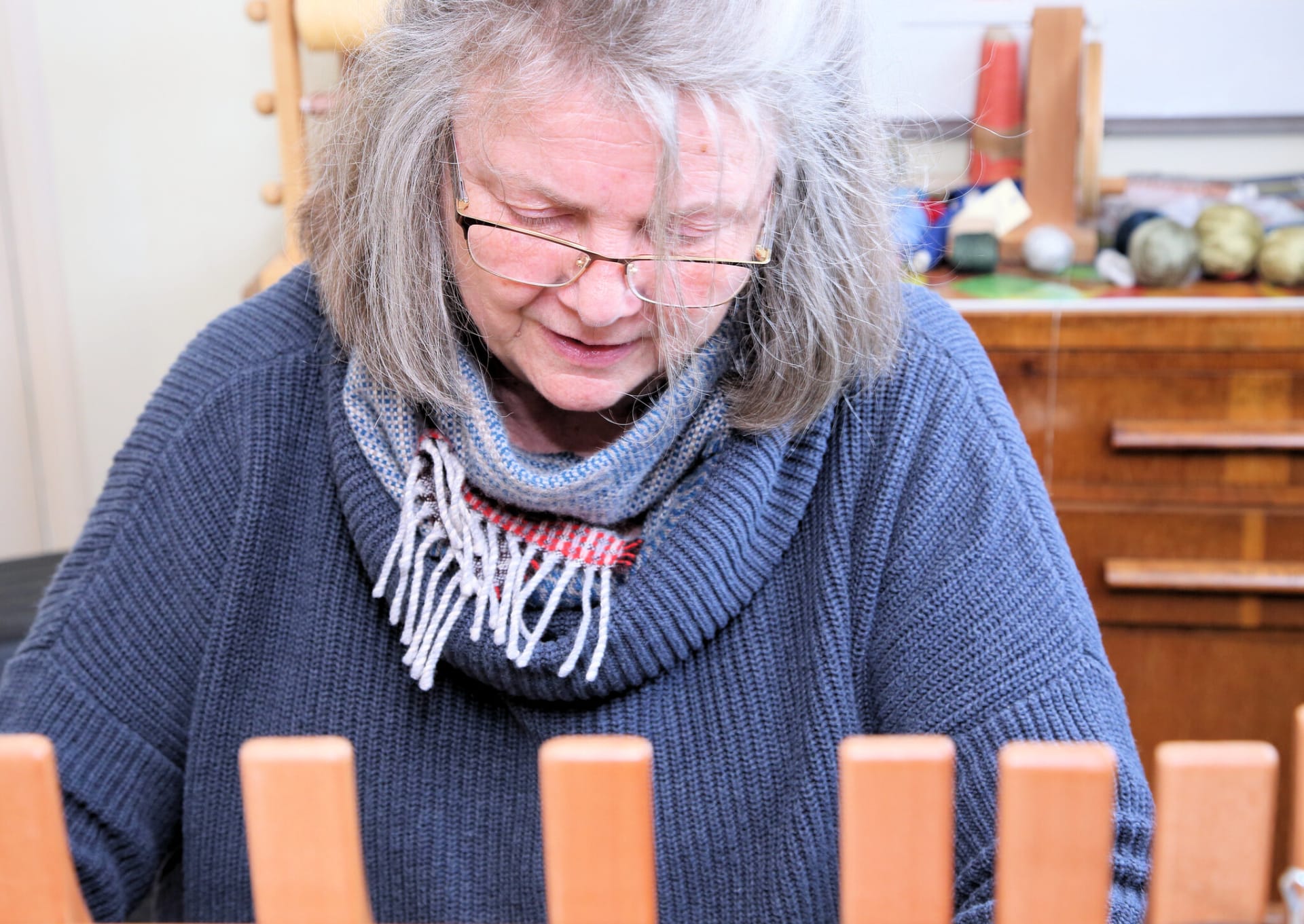Back in November we launched a competition on behalf of the Oxford Festival of the Arts (OFA) to find a cover design for their 2020 festival brochure. Entrants were to take their inspiration from ‘The Field of Cloth of Gold’, a painting that depicts the extraordinary meeting between Henry VIII and Francis I five centuries ago. The results are in and Festival Director Dr Michelle Castelletti has chosen the winner – local artist and weaver, Julia Engelhardt.
Julia was born in Germany but has lived in Britain for more than forty years. “I’ve always been very dextrous and liked textiles,” she tells us from a jubilant OFA office. “I think my first experience of weaving was when my parents brought back a little Chimayo weaving from the US and gave it to me when I was eight. I can still see this piece. They got me a loom so I wove for a year or two – just little pieces like one does as a child – and as I say, I always liked to do things with my hands.”
During a career as a picture researcher she didn’t have the chance to engage her love of making, and so upon becoming freelance and moving to Oxford in 2006, she decided it was time to start doing things with her hands. “I went on a little search for a while and went on a course with weave designer Margo Selby. I came back with two beautiful pieces that I wove myself, but it was all on pre-set up looms.”
Through a laugh she says this presented a challenge, as she had no idea how to set up or 'warp up' a loom. She decided to figure it out for herself since she wanted to begin making beautiful pieces of her very own. “I got a table loom but with eight shafts. You can do quite a lot with eight shafts," she explains. “Starting from the very simple using two or four shafts to quite complex pieces using all eight. I work with another table loom with 16 shafts but beyond that you really need to have a large, possibly mechanised loom. So essentially I am self-taught.”
She calls her pieces ‘Weavescapes’ and with all the texture, movement and dynamism contained within, it’s clear to see why. Her work sits in a beautiful mid-ground between craft and art (akin to painter Paul Klee, a hero of hers, who taught form and colour theory to the weaving workshop at the Bauhaus) while producing such intricate work engages both the analytical and aesthetic sides of the brain, requiring absolute concetration. So when she saw the OFA brief, what did she think? “Tailor-made for me!” she replies joyfully - and in retrospect it's hard to imagine a more fitting winner. She was to expand on a previous piece called 'Ceremonial Cloth' for Artweeks, so when the competition came along, it was a perfect match.
Julia produced two pieces for the competition, ‘Cloth of Splendour’ and ‘Cloth of Renaissance Kings’, and while the former was chosen for the brochure cover, both will be on show throughout the festival. Indeed, so pleased were the organisers that the design of the whole brochure has changed to accommodate as much of Julia’s work as possible. Festival Director, Dr Michelle Castelletti, is clearly over the moon. “I’m absolutely thrilled,” she says, beaming at the framed pieces. “We never expected to receive something which is a 3D textile full of textures. When you do a competition you imagine you’re going to get paintings or a design. Never in my life have I received a woven textile, and it couldn’t be better, because we have our own cloth of gold!”

The meeting between Henry VIII and Francis I was a truly remarkable occasion. In the spirit of kinship between Christian nations, the two Renaissance rulers met at Balinghem, a place equidistant from each of their kingdoms. The summit lasted for three weeks and included huge feasts, music, jousting, opulent tents, lavish clothing and games. While the meeting was one of companionship, the two monarchs were certainly trying to outdo one another with the splendour on display.
As you can see from the image, Julia chose many of her materials to tease out and reflect many aspects of the Field of Cloth of Gold in her ‘Cloth of Renaissance Kings’ after the 16th century painting. The green wool represents the hilled landscape and the fact that much Tudor wealth was built on the wool trade. The shimmering golds and yellows reflect the exuberance and wealth of the event, while at the bottom, if you look carefully you can see an offset pattern constituting the faintest allusion to the Fleur de Lys. Dr Castelletti is similarly delighted with the parallels as she explains, “I don’t think we could have chosen a better theme or inspiration. It’s 500 years from an anniversary which is not known by everyone by its name, but it was a very big deal. International relations is very important at the moment, very important in the arts. It was trying to create peace – even though Henry did lose his wrestling match with Francis so he wasn’t a happy bunny after that – but it also encapsulates three weeks of just lavish entertainment, splendour and music; everything we’re trying to do in the festival.”
OFA is currently assessing whether they can go ahead with the festival as planned – we will update as we get more information. If you’d like to contact Julia about her work see her Instagram and website.
Portrait above by Philip King Photography - all others by Keith Barnes Photography.










